September 17, 2021-December 18, 2021
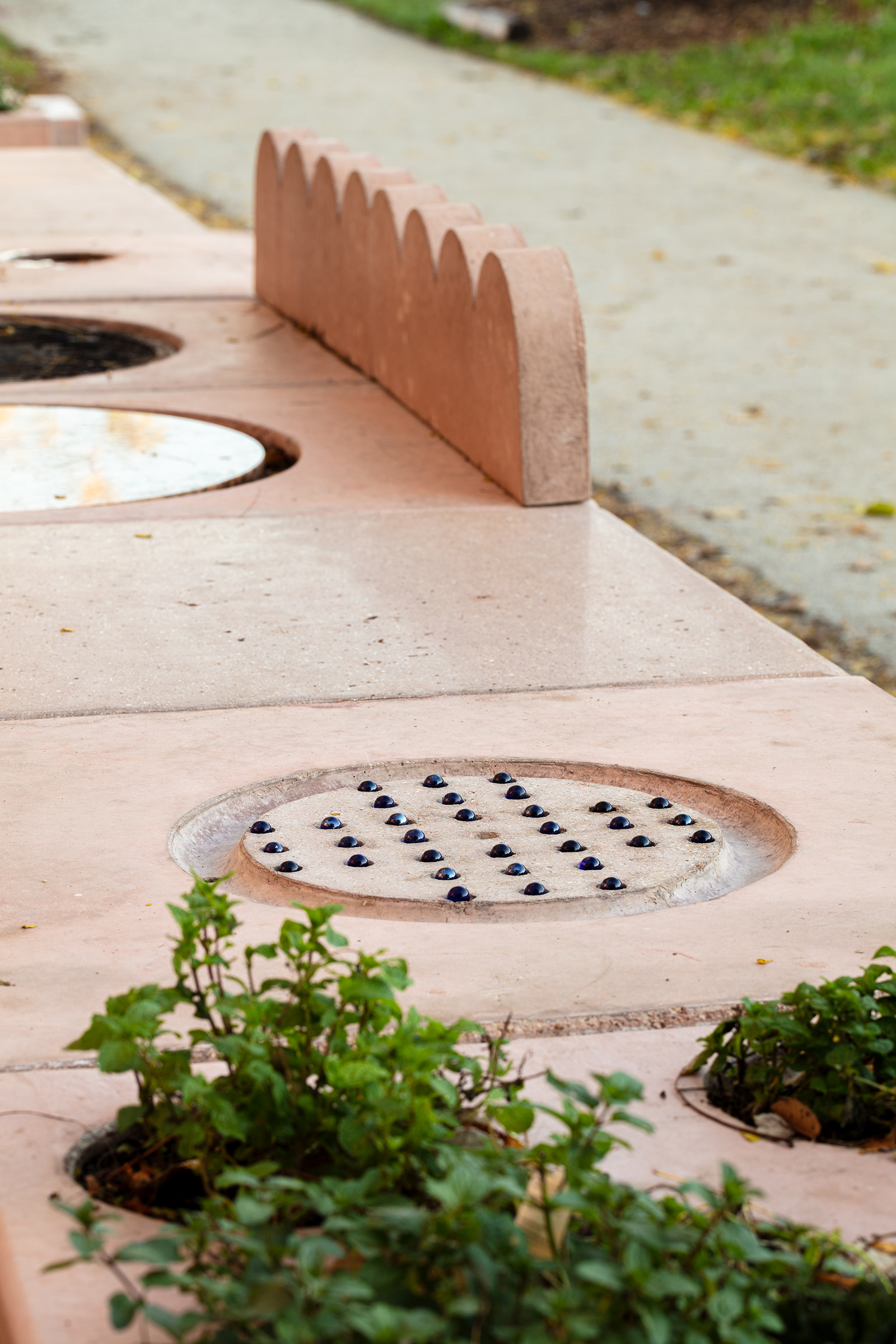
It seems so simple. An exhibition about architecture, showing what architects do, complete with models, drawings, a few full-scale installations, and the occasional roundtable discussion. And just maybe it was simple when the audience was assumed to be a homogenous cadre of mostly middle-aged white men who have historically controlled the dialogue within the field. With the critique of such a show also in the hands of that same group, the question of who the show is for and who might be affected by the work presented has long felt like a secondary concern. We don’t live in that world anymore.
The last fifteen years have seen the seemingly endless propagation of architecture biennials and triennials around the world. While the Venice Biennale is still the “main event,” other shows have worked to find their niche. The 2015 inaugural Chicago Architecture Biennial (CAB) brought together a slew of young international firms contributing their often spectacular visions for the future to much fanfare. But the pandemic, and a growing focus on the host city of Chicago, have transformed the show into something scarcely recognizable.
The Available City, the 2021 edition of the CAB, problematized the typical means of architectural exhibitions. Shifting the focus away from spectacle and esoteric discipline discussions, the show changed the conversation to contextual and cultural impact. The simple reading of the show’s emphasis on community engagement underlies a profound question of how architects believe their work can affect the public—a public that has too often been abused by the many systems architecture is intrinsically engaged with.
The Venice Biennale has progressively reassessed its core themes toward future forms of coexistence, social problems, and sustainability in the past decade. Yet, outside of the context of the oft luxurious Venetian palazzos, gardens, and teak water taxis, it is sometimes hard to recognize actionable, impactful work while sipping prosecco canal-side. At best, the presented projects are truly novel ideas that may have a lasting effect on communities far from Venice; at worst they are fetishizations and aestheticizations of urgent issues for the self-gratification of the architecture profession. It’s at this point that the 2021 Chicago Architecture Biennial drastically departed in form and focus, attempting direct action.
It is no secret Chicago has suffered through systemic segregation through redlining, unequal distribution of resources and services, and government brutality manifested in policy and unchecked law enforcement. The story of Chicago is amplified through national news coverage and political debate, as much as it has been ignored and obfuscated by those who may have the power to address its hard truths. The nationwide protests in response to the murder of George Floyd at the hands of a police officer in 2020 reiterated the pleas of people in Chicago to those in power to recognize fundamental human rights and exercise accountability. These events underscored the lack of recognition and representation that the field of architecture has long struggled to acknowledge, let alone address.
The choice of David Brown as artistic director for the 2021 edition was fortuitous in a year of disruptions, postponement, and social distancing. Brown, an associate director and professor at the University of Illinois-Chicago School of Architecture, has spent more than a decade focusing on the some 10,000+ city-owned vacant lots dispersed throughout Chicago. His project, the framework for The Available City, explores the potential for improvisation as a means to address these holes in the city’s fabric, both physically and socially. Notably, the glut of these lots is in predominantly underserved Black and brown communities on the South and West Sides. It would be hard to imagine a premise for a show more fitted for this moment.
For the past three installments, the CAB has been physically centered around the nineteenth-century Beaux-Arts Chicago Cultural Center, the city’s former central library. The move from the Cultural Center is much more than a geographic change, though. The relocation and dispersion of the show also mark a fundamental shift in how participants interact with the larger Chicago community. Rather than the often behind-the-scenes negotiations between artistic directors and participants, the show’s large commissioned projects engaged with one or more community stakeholders or local public figures. This resulted in a growing anticipation in their respective communities, and a project that addressed specific actionable issues with physical or spatial considerations.
The Dutch/Italian team Studio Ossidiana created The Garden Table in collaboration with the El Paseo Community Garden and NeighborSpace on Chicago’s Near South Side neighborhood of Pilsen. The project consists of long, modular street furniture that adds formal and physical presence to the linear El Paseo Community Garden. Constructed entirely of pastel concrete, it is a permanent and expandable addition to the neighborhood. Part table, part grill, part game board, part play gym, Table provides thoughtful and spatially engaging amenities that, if even offered otherwise, would likely have been generic off-the-shelf pieces.
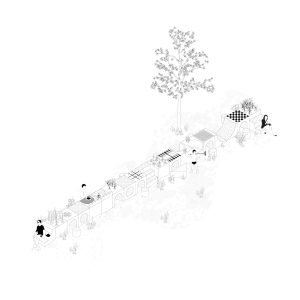
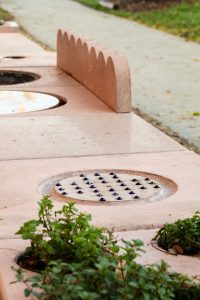

Taking a similar tack, Studio Barnes constructed Block Party, an architecturally rich play gym in North Lawndale. Block parties are a Chicago institution, informally organized community care events in underserved neighborhoods. The founder of Studio Barnes, Germain Barnes, who grew up on the West Side, has enjoyed and participated in countless block parties, and organized one for the opening of his piece. Block Party doesn’t resemble the play equipment found in so many playlots across the city. Instead, the bright pink structure —so colored in reference to the Pink Line L train, which flies past the site— is a nod to the ubiquitous block party bounce houses. Ironically, while block parties were one of the few relatively safe forms of public gatherings in the past two years, bounce houses were banned for much of that time as a COVID-19 precaution.
In collaboration with the Morton Arboretum, the Field Museum, University of Notre Dame and the PalEON Project, and the US Geological Survey, Hood Design Studio engaged with space and time at a true city scale with new Witness Trees in Washington Park. The title refers to both nineteenth-century surveyors’ “bearing trees,” planted throughout the region, and the cultural concept of witness trees, trees that live through and organically record historical events. The installation is a planting of sixteen bald southern cypress trees, bringing a symbol of the south to the north and evoking the Great Migration, which defined so much of the culture of Chicago to this day. Unlike the disposable nature of many architectural installations, new Witness Trees, like a number of the other projects produced for the show, will continue to serve the community in perpetuity.
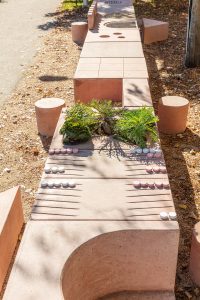
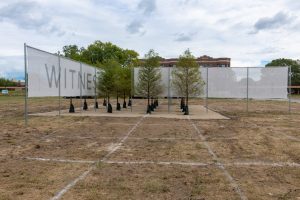
Along with the projects mentioned above, an addition to a permaculture garden, a new bike repair shop, and a number of large-scale painted pieces could be found throughout the city, to name a few. With each of these projects—matched with in-person and remote public presentations or educational events—the tone of the entire Biennial was contrary to nearly any other architecture exhibition, even those with social issues at the core of their theme. Gone were the roundtable debates filled with architects and curators, replaced by the voices of social scholars, community activists, historians, and maybe an architect. This promoted conversations that are not new but are definitely uncommon in the larger architectural discourse.
Before turning our thoughts to the next CAB edition, which always seems to come so quickly, we have a brief moment to reflect. Even with an understanding of the 2021 edition’s mission and accomplishments, it is challenging to assess whether it was a success. Somehow it seems that that success (or failure) is at once very personal, specific to the people who engaged with the show, and very broad, encapsulating the many communities and organizations (mostly outside of architecture) that were affected. At the least, this show asks us to look more deeply and with more patience at the effects of architecture on the places we build. The Available City asks us to rethink everything from how we practice to how we engage with the greater public. And we are long overdue for that reflection.
Matthew Messner is a designer and critic. Currently, he is an adjunct professor at the Illinois Institute of Technology and the University of Wisconsin – Milwaukee. Professionally, he is a designer at the Chicago-based Brininstool+Lynch. He is the former Midwest editor of The Architect’s Newspaper, and former project coordinator for the 2015 Chicago Architecture Biennial.
How to Cite This: Messner, Matthew. Review of The Available City: 2021 Edition of the Chicago Architecture Biennial, Chicago, IL, September 17 – December 18, 2021, JAE Online, July 1, 2022.






